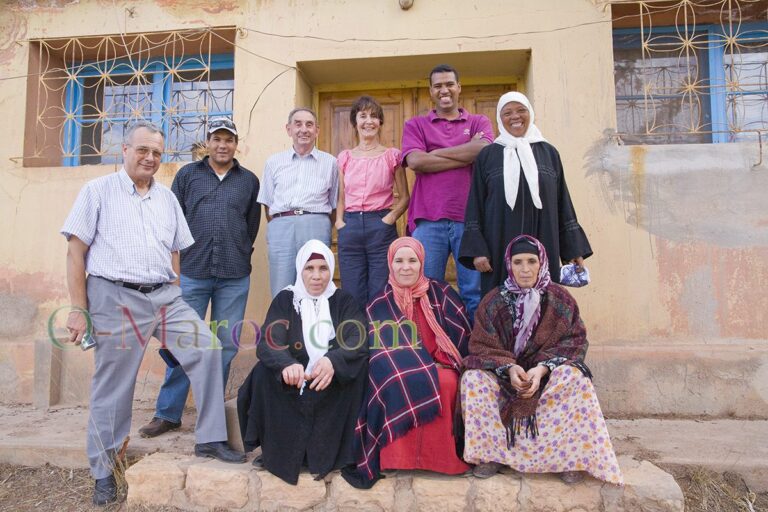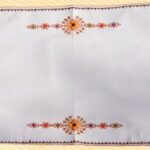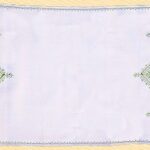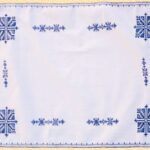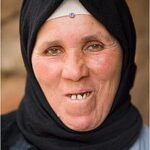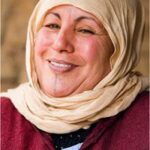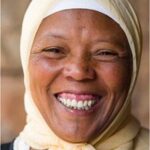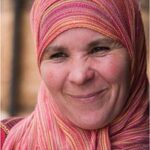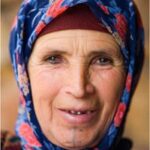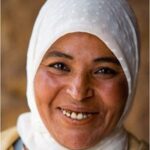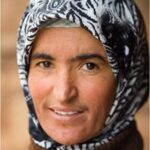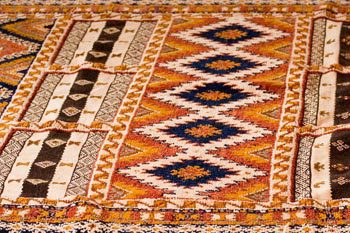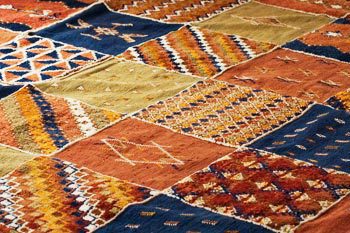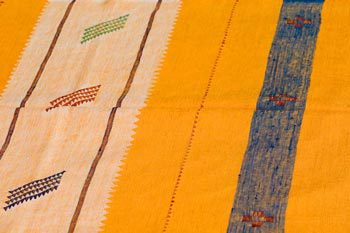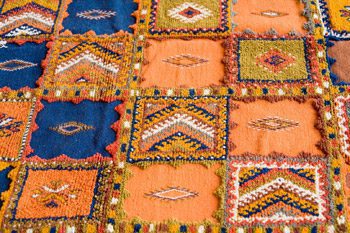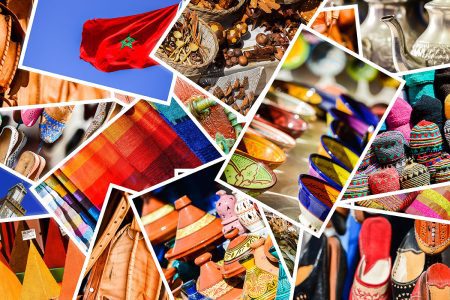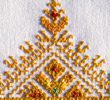
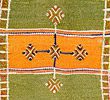
One of the oldest cooperatives in Morocco, run exclusively by women, it makes Berber rugs and embroidery in the best Moroccan tradition. These are excellent quality products, which you can admire on the spot, during a hike in the Atlas mountains, on an excursion to Telouet, or on a journey between Ouarzazate and Marrakesh.
The Grand Atlas cooperative in Agouim was founded in the 1950s.
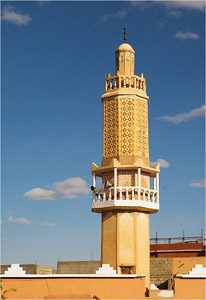
Although Agouim is now a small village just passing through, an hour’s drive from Ouarzazate on the road to Marrakesh, it was much busier at the time, because of the Imli mines. A handful of Franciscans opened a dispensary in Agouim and soon set up two cooperatives, carpentry for the men and rugs and embroidery for the women.
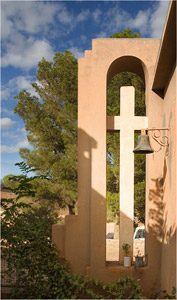
They give them “convent-quality” training that corresponds to the superb embroidered works that can be bought in monasteries in France, but using traditional Moroccan techniques and motifs. The training is then passed on by the best workers, who take charge of training young girls in a special structure, the Nadi. Generations have been trained in this way, and although the school has to evolve, the girls now often go to college and join the Nadi after their studies.
A few years ago, the last Franciscan retired, and the women decided to take over the cooperative themselves. This was not without its difficulties, as they now had to take on new tasks – administration, marketing – and most of them were illiterate. But they managed to keep the structure afloat.
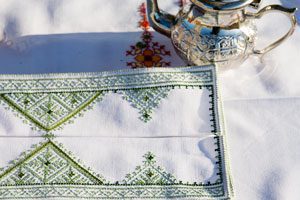
The traditional weaving loom
For a nomad, after the tent cloth woven from dromedary wool, the rug is the first, if not the only piece of furniture. From the khaïmas of the Atlas mountains to the rich Glaouis or Fassis palaces, the rugs are numerous, soft, colourful and richly decorated. They cover the floor, where they can be piled up in several layers; in winter they are hung on the walls to protect the tiles from the cold; they cover sofas and beds, and the smallest can also be used as clothing, like the Handira from the Atlas… In the past, every family had a loom where young girls prepared their wedding trousseau.
To find out more about how rugs are made, click here.
The traditional loom is vertical and can be dismantled. With this type of loom, the rugs have only one fringe. Once the rug is finished, it is dismantled and taken to another house, where it will occupy a large part of the main room for a month, or more if the rug ordered is large. The width of the rug is limited by the size of the loom, but not its height.

Two women, sometimes three, can sit side by side and weave together, to go faster. In the photo, they will sit with their backs to the wall on the little stools, legs together, for several hours.
Younger girls can also take part, and start learning needlework with their mothers, before doing a more serious apprenticeship at the Nadi.
The cooperative’s production capacity is therefore limited by the number of looms available, with only eight families able to weave simultaneously.
Embroideries
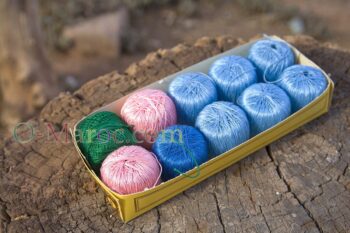
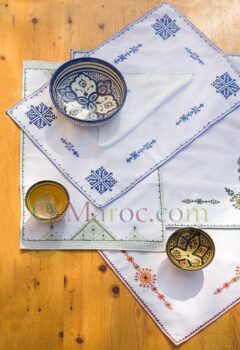
The embroidery is done in Fez stitch. Fez embroidery, the Moroccan equivalent of cross-stitch, is an art that all little girls learn. Its distinctive feature is that it is identical on the front and back, when the work is well done. It can be found everywhere, on clothes, table linen, bed linen, cushions and wall hangings used to decorate wedding festivities, etc. Most often in monochrome, or in a gradation of shades, it can also be found in bright colours.
Agouim embroidery is made from pure cotton, DMC threads on a thick, tightly woven fabric, giving a very regular pattern and strong linen..
Table mats
By 6, with patterns in shades of the same colour. Matching napkins are also available. Assorted colours can be made to order. Dimensions: 33 * 50 cm
Gift pouches
To accompany a piece of jewellery, or any other small gift, fill with lavender or a homemade potpourri, small pouches of various sizes, closed with a braid matching the colour of the embroidery.
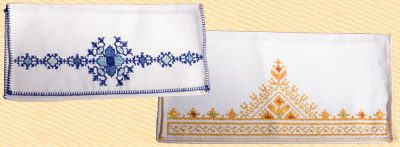
The colours shown in the photos are not the only ones possible, of course.
Posts are generally also available in green, red, blue or yellow.
The women of the cooperative
The Agouim cooperative has around 200 women members. In each family, several women can work, even if only one of them is a member of the cooperative.
In the absence of looms, only 8 families can weave simultaneously. Embroidery, on the other hand, is done all the time, in groups, at home, on a stool in front of the father’s or husband’s shop… The cooperative estimates that around a thousand people work for it at one time or another.
Treasurer.
Married, three daughters
Vice-president
Married, 4 daughters and 1 son
President
Married, one daughter
Vice treasurer and councillor
Married, 2 boys and a girl
Co-operator
Single
Co-operator
Married, 3 boys and 2 girls
Co-operator
Single
Where can you buy the cooperative’s products?
Fez embroidery
They can be purchased by mail order, at trade fairs or on site.
Moroccan rugs are only available on site
In Agouim, you’ll find kilims (mergoum in Berber), and woven and knotted rugs. Using the same technique, the women also make matching cushion covers and hangings that you can use as curtains. Depending on their size and the complexity of their designs, prices vary from a few dozen to a few hundred euros.
Getting to Agouim
Although the small village of Agouim is unremarkable, it can be a good starting point for a hike in the Atlas massif. The Gandini guides also give a circuit passing through Agouim. You can also easily go there as part of an excursion from Ouarzazate, for example on your way to visit Telouet.Although the small village of Agouim is unremarkable, it can be a good starting point for a hike in the Atlas massif. The Gandini guides also give a circuit passing through Agouim. You can also easily go there as part of an excursion from Ouarzazate, for example on your way to visit Telouet.
2006 – 2021: the cooperative is still running
This post was written in 2006, following a trip to the site with the MCA association and Father Joguet, from the diocese of Rabat.
In fact, the departure of the Franciscans, who were in charge of marketing, posed major difficulties for the women: obliged to take charge of this activity, they did not have the means to do so, often for language reasons, but also for cultural reasons: if Berber women can go to the market to sell their products, they will not travel all over Morocco.
There was also a men’s cooperative in Agouim, mainly for carpentry, which faced the same kinds of difficulties, but the men managed to get by.
At the time, our travel agency, Mezgarne, had an online shop. We went there to meet the women and promote their products. Then trainees and development workers took up the torch, websites multiplied and the cooperative continued to live on.
Stabilisation with Amnougar
Amnougar is an association based in Ouarzazate (I’ll have to je vous parle un jour), which trains young disabled people in craft trades. It has taken over the marketing of Agouim’s products, and helps them to organise their exhibitions, once or twice a year, when Covid gives them the chance!
To contact the Agouim cooperative
You can contact them via their Facebook page, which gives details and telephone numbers, and shows photos of the products, which have diversified.
As well as traditional designs, the cooperative also offers simpler designs, which can be sold more easily at lower prices.
The cooperative and Agouim were badly hit by the earthquake.
In particular, the wall of the cooperative was destroyed.
More details on the MCA non profit blog.
 A typo or syntax error? You can select the text and hit Ctrl+Enter to send us a message. Thank you! If this post interested you, maybe you can also leave a comment. We'd love to exchange with you !
A typo or syntax error? You can select the text and hit Ctrl+Enter to send us a message. Thank you! If this post interested you, maybe you can also leave a comment. We'd love to exchange with you !

